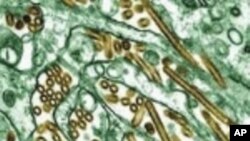Eight nations and the European Commission, the executive branch of the European Union, have pledged more than four-hundred-million dollars to fight the spread of H5N1 avian influenza. The United States made the largest donation – some one-hundred-ninety-five million dollars. U.S. Special Representative on Avian and Pandemic Influenza John Lange announced the U.S. pledge on the final day of a three-day conference in New Delhi, India. Delegates and ministers from one-hundred-eleven countries attended the conference.
This year’s pledge brings the total U.S. contribution to avian flu assistance since 2005 to nearly six-hundred-thirty million dollars. The U.S. funds will support the efforts of international organizations, nongovernmental groups, and others to strengthen global preparedness and response to avian flu and a potential human flu pandemic.
According to the World Health Organization, since avian flu emerged in Asia in 2003, some sixty nations have had confirmed outbreaks of the virus and more than two-hundred people in twelve countries have died of it. The threat is great that this or some other virus will mutate and initiate a human pandemic. Dr. David Nabarro is United Nations system coordinator for avian and pandemic influenza. He says the financial pledges are important, “but we are also looking for longer-term commitments to improved animal health and human health security beyond the kind of pledgings done at this conference, and to longer-term development assistance in these areas.”
Conference participants reported that progress has been made in combating avian flu. More than ninety percent of one-hundred-forty-three countries surveyed have developed pandemic preparedness plans. Though the threat continues, the capacity to diagnose and track flu viruses has improved. “Countries are much better prepared now than they were a year ago for a pandemic,” said Dr. Nabarro. “However, the preparedness is not as broad or deep as we would like it to be,” he said.
U.S. Special Representative on Avian and Pandemic Influenza John Lange said that while progress has been made, more must be done to improve the capacity of health systems to meet the threat of avian flu and other potential pandemics.












